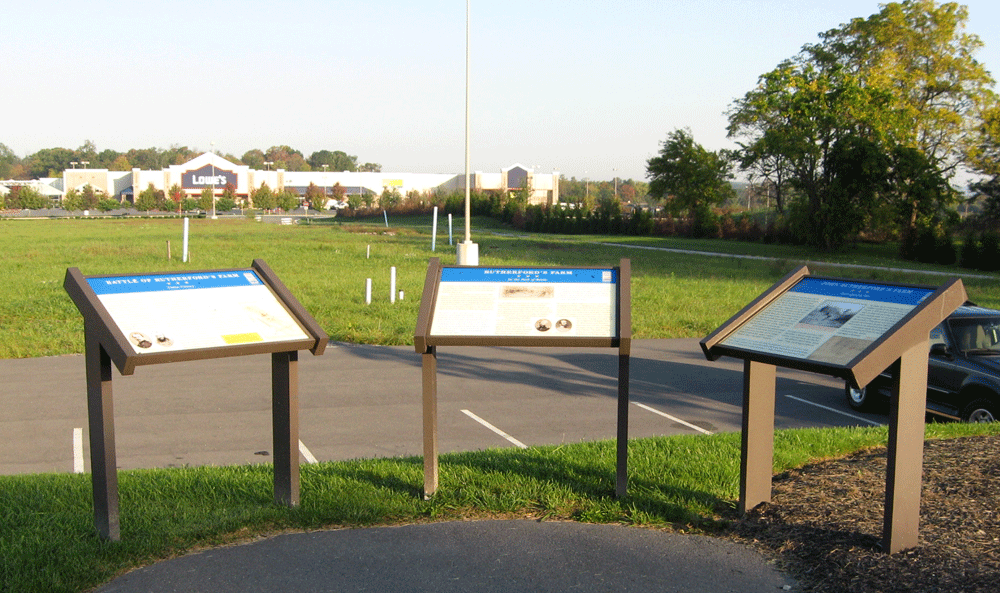The Rutherford’s Farm – In the Path of the Battle wayside marker is the third of a set of six on Rutherford’s Farm northeast of Wnchester, Virginia. They have been relocated to a small park due to highway and land development.

From the marker:
Rutherford’s Farm
In the Path of the Battle
“We drove to Mrs. Carter’s where there were some more wounded Yankees, to offer [our supplies] for their use, but the Surgeon said, his men had been so kindly treated by the citizens that they would not need them. I told him that when his men were suffering, with ours, I always shared my supplies with them; I never let a Yankee think I am a Union woman.”
– Mary Greenhow Lee, diary, July 23, 1864
“The enemy … advanced from the wood and charged our line of skirmishers. … A short but closely contested struggle ensued, which resulted in the repulse of the enemy. Many prisoners were taken, and quite a number on both sides left on the field.”
– Gen. George A. Custer
In addition to the action of July 20, 1864, known as the Battle of Rutherford’s Farm, two other significant events occurred on or near John Rutherford’s property here.
The first took place on June 14-15, 1863, during the Gettysburg Campaign, as Union Gen. Robert H. Milroy’s army evacuated Winchester and fled north. Milroy had constructed fortifications around Winchester, but Confederate Gen. Richard S. Ewell’s corps, the vanguard of Gen. Robert E. Lee’s Army of Northern Virginia, captured one of them on June 14. Milroy’s 7,000 men slipped away in the night and marched by here on the turnpike behind you. Confederate Gen. Edward “Allegheny” Johnson pursued them, caught up near Stephenson’s Depot two miles north of here, and captured about half of them. The Second Battle of Winchester and the surrender at Stephenson’s Depot were humiliating Federal defeats.
On September 19, 1864, the Third Battle of Winchester (or Opequon) pitted Union Gen. Philip H. Sheridan’s army against that of Confederate Gen. Jubal A. Early. Sheridan attacked with most of his infantry from Berryville, east of Winchester. He sent Gen. Wesley Merrit’s cavalry division swinging northwest to Stephenson’s Depot, where it joined Union Gen. William W. Averell’s cavalrymen and then headed south toward the city. Just north of here, the cavalrymen attacked Confederate Gen. Fitzhugh Lee’s cavalry and Gen. Gabriel C. Wharton’s infantry, driving them back through here. Gen. George A. Custer led one of Merritt’s brigades down the Winchester and Potomac Railroad line and the turnpike through Carter’s and Rutherford’s farms. The battle ended as Early’s army fled south of Winchester to Fisher’s Hill.
From the caption to the drawing at the top:
Gen. George A. Custer’s cavalry charging and capturing prisoners near the turnpike, September 19, 1864.
Courtesy Library of Congress
From the captions to the photographs at the bottom:
Gen. Robert H. Milroy
Gen. Richard S. Ewell
Courtesy Library of Congress

The marker is one of three wayside markers relocated to a small park east of the Rutherford Crossing shopping center
